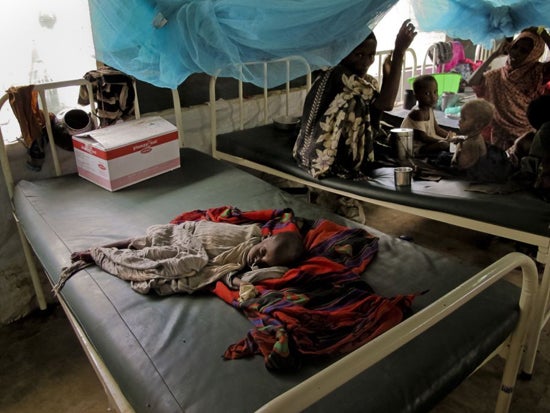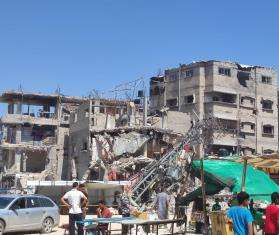MSF is seeing a dramatic effect on the Somali population—both those in Somalia and the many who have fled to overcrowded camps in Dadaab, Kenya, and parts of Ethiopia.

Kenya 2011 © Yahya Dahiye/MSF
A malnourished child rests inside MSF's inpatient therapeutic feeding center in Dadaab.
Drought currently affecting the Horn of Africa is exacerbating already precarious conditions for many people in eastern Africa. Doctors Without Borders/Médecins Sans Frontières (MSF) is seeing a dramatic effect on the Somali population—both those in Somalia and the many who have fled to overcrowded camps in Dadaab, Kenya, and parts of Ethiopia. The numbers of malnourished children in MSF feeding programs in these areas are rising. This, along with the conflict in Somalia, limited access to healthcare, high food prices, and inadequate aid amounts to a widespread humanitarian crisis.
Somali Refugees Wait For Aid in Dadaab, Kenya
The Dadaab refugee camp complex in northeastern Kenya consists of three camps: Ifo, Hagadera and Dagahaley. It constitutes the largest refugee camp in the world with more than 370,000 inhabitants, and it is beyond full. But, thousands of Somali refugees continue to arrive every day, fleeing the violent conflict in their home country and the devastating effects of the drought and lack of food. Between June 6 and July 6, approximately 40,000 people arrived in Dadaab in search of humanitarian assistance and safety. Most of the newly arrived refugees have been forced to settle in the outlying areas of the official camps; MSF estimates about 25,000 people are living on the outskirts of Dagahaley camp alone. New arrivals have to build crude shelters in the desert and have more difficulty getting food and adequate clean water. Inside the camps, the healthcare system is struggling to meet the needs.
MSF teams conducted a rapid nutrition assessment on the outskirts of one of the camp sites and found extremely high malnutrition rates among the new arrivals: 37.7 percent of the children between six months and five years old were suffering from global acute malnutrition; of these, 17.5 percent were severely malnourished and at high risk of death. Of children between five and 10 years old, 43.3 percent were malnourished.
As a consequence, MSF admitted 320 children with severe acute malnutrition into their inpatient therapeutic feeding center in June—three times as many patients as in the same month last year. MSF is currently treating a total of 1,600 children for severe acute malnutrition, and 1,742 children with moderate acute malnutrition are enrolled in the supplementary feeding program.
MSF also found that among the new arrivals the average amount of water received is three liters per person per day—a far cry from the international emergency standard of 20 liters.
At the current pace, according to UNHCR figures, the Dadaab camp’s population will total 450,000 before the end of 2011.
There are unacceptable delays in the registration of newly arrived refugees. While a 15-day food ration provided upon arrival has been in place since July 2011, it still takes more than a month to be registered and there is no guarantee that a second food ration will be distributed. Many people already in the camp share their food rations with newcomers. MSF is not only seeing children newly arrived from Somalia suffering from malnutrition; teams also see children who have become malnourished while living in the overstretched camp.
Access to essential services such as water, sanitation, food, and shelter is continually shrinking and living conditions are only expected to deteriorate further unless camps and services are significantly expanded. Kenya's prime minister Raila Odinga has announced that a new camp, Ifo II, which can accomodate up to 80,000 people, will open by July 24. MSF welcomes this news, but remains deeply concerned for the hundreds of thousands of others, those already in Dadaab who will not make it into the new camp, and those who will continue to seek refuge in Kenya.
Action Needs To Be Taken in Ethiopia
In the camps of southern Ethiopia's Liben District, which borders Somalia, 37 percent of the children under five screened by MSF were found to be malnourished. Currently, teams are treating more than 7,000 children in nutritional programs and providing primary healthcare to refugees.
A year ago, camps in Liben hosted 27,000 refugees. As of July 15, 2011, the sites that were designed to accommodate 45,000 people were hosting 107,000. There is an average of 1,400 new arrivals per day (2,800 people arrived on June 28), and insufficient humanitarian assistance is making the overcrowded situation even worse.
A number of problems in the registration procedure have led to considerable delays in people receiving humanitarian assistance, particularly food distribution—making the nutrition situation even worse—water and sanitation, and provision of shelter.
MSF is increasing its capacity to respond to the growing needs, but its operational limits are being reached. Other organizations’ engagement is essential in order to respond adequately to the nutritional crisis. A comprehensive humanitarian response is needed in order to prevent further deterioration in the camps.
MSF is also seeing a rise in the number of malnourished children being treated in its primary healthcare center in East Imey, in the Somali Region of Ethiopia. The population in this remote area is affected by chronic poverty, droughts and floods, as well as a lack of public services.
Access to adequate nutrition in this area may become a serious issue before the next rainy season, which will start in October 2011. In addition to following closely the number of patients admitted each week, MSF is planning to conduct nutritional screenings as a component of its mobile clinic outreach activities in the area in order to get a better understanding of the nutritional situation of people there and in neighboring locations.
In Somalia, Seeing Numbers Rise, Pushing For More Access
MSF’s teams in Somalia have witnessed a sharp increase in malnutrition cases, but given the extreme insecurity, it is difficult to get a clear picture of the situation outside of MSF clinics.
In Marere, in Lower Juba region in the south, MSF teams are seeing a surge in the numbers of patients, most of whom have malaria or are malnourished. As of July 14, teams were treating 131 children in the inpatient therapeutic feeding center and about 700 in ambulatory therapeutic feeding centers in three locations. Some patients have been traveling hundreds of kilometers to reach the centers. Teams are working to streamline the triage process and create additional space for inpatients. At the same time, people displaced by the conflict or by the effects of the drought continue to arrive at a makeshift camp in Jilib, 20 kms (12.4 miles) north of Marere. As of July 8, there were 800 families taking refuge there. The MSF team was waiting for the delivery of plastic sheeting, mosquito nets, and soap to distribute to families.
In the town of Dinsor, located in Bay region in the southwest, MSF teams are seeing higher numbers of children in their nutritional programs. The number of cases in Dinsor is double that of the same period last year; in mid-June, more than 600 children were being treated through ambulatory therapeutic feeding centers and 120 were being treated as inpatients.
Northwest of the capital Mogadishu, in Afgooye, MSF is supporting a community hospital where 497 children were admitted for malnutrition in June. At MSF’s project in Jowhar, in central Somalia’s Middle Shabelle region, 944 malnourished children were being treated.
Relative to other areas in Somalia, the Galgaduud region of central Somalia has not been as affected by the drought in terms of malnutrition. Nevertheless, MSF teams are treating an increasing number of malnourished children in hospital wards currently operating above full capacity. The 30-bed pediatric ward in Istarlin Hospital is stretched beyond its limit, treating 70 children.
MSF is preparing to scale up its activities in Somalia. Negotiations with all parties on the ground have been ongoing with the aim of gaining access to areas where people do not have adequate access to food or medicine.




